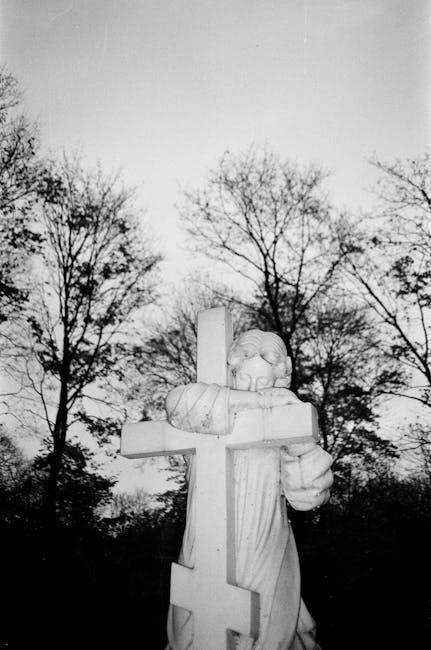This poem by Emily Dickinson explores themes of mortality, eternity, and the afterlife through a unique and profound narrative voice. It delves into the speaker’s calm acceptance of death, personified as a courteous suitor, and the eternal journey that follows. The poem’s haunting imagery and philosophical depth have made it one of Dickinson’s most celebrated works, offering a timeless reflection on life’s mysteries.
Overview of the Poem
Emily Dickinson’s “Because I Could Not Stop for Death” is a profound and enigmatic poem that explores the encounter between the speaker and personified Death. The poem unfolds as a serene and introspective journey, where Death, portrayed as a courteous suitor, pauses for the speaker. Together, they embark on a carriage ride through eternity, passing by symbols of earthly life, such as fields, schools, and houses. The speaker reflects on the fleeting nature of mortal concerns, while Death, with immutable patience, guides the journey into the afterlife. The poem’s structure, with its characteristic Dickinsonian dashes and unconventional rhyme, adds to its haunting beauty and philosophical depth.
Historical Context of the Poem
Emily Dickinson wrote “Because I Could Not Stop for Death” during the mid-19th century, a time marked by the American Civil War and heightened awareness of mortality. The poem reflects the cultural attitudes toward death and the afterlife prevalent during this period, when death was a more openly discussed and accepted part of life. Dickinson’s reclusive lifestyle and personal experiences with loss also influenced her exploration of existential themes. The poem’s philosophical depth and unique style resonate with the transcendentalist ideas of her era, which emphasized individualism and the mysteries of the universe. This context enriches the poem’s timeless meditation on life, death, and eternity.

Themes and Symbolism
The poem explores themes of death, immortality, and eternity through symbolic imagery, such as the carriage ride, representing life’s journey and the transition to the afterlife.
The Concept of Death and Immortality

Death is portrayed as a gentle suitor, embodying a calm acceptance of mortality. The poem transcends fear, presenting death as a natural transition rather than an end. Immortality is subtly explored through the eternal nature of the soul, contrasting with the finite world. Dickinson’s unique perspective on death and the afterlife reflects her philosophical questioning of life’s mysteries. The poem’s serene tone and symbolic imagery, such as the carriage ride, evoke a sense of inevitability and peace, challenging traditional fears of death. This concept is central to the poem’s exploration of existential themes, offering a profound meditation on life’s fleeting nature and eternal possibilities.

Symbolism of the Carriage Ride
The carriage ride symbolizes the journey from life to death, representing a transition to the unknown. It creates a sense of inevitability, as the speaker moves toward eternity. The imagery of the carriage, driven by Death, embodies a calm acceptance of mortality. This duality of death and eternity is central to the poem’s exploration. The ride’s slow progression reflects the passage of time and the speaker’s detachment from earthly life. The carriage serves as a metaphor for the soul’s transition, emphasizing the inevitability of death and the eternal nature of existence. Dickinson’s use of this symbol underscores the serene and philosophical tone of the poem.

Representation of Eternity and the Afterlife
In “Because I Could Not Stop for Death,” Emily Dickinson portrays eternity and the afterlife through imagery and philosophical reflection. The poem suggests that eternity transcends human comprehension of time, as the speaker describes centuries passing “Since Then.” The afterlife is depicted not as a judgement but as a serene, timeless state. Dickinson’s imagery of the setting sun and the “Horses’ Heads” evoke a sense of slow, inevitable progression into eternity. The poem’s structure, with its dashes and unconventional rhythm, mirrors the infinite and unbounded nature of eternity. Ultimately, the afterlife is represented as a realm where time loses meaning, emphasizing the eternal over the temporal, and offering a profound meditation on existence beyond life.

Literary Devices and Style
Dickinson’s unique syntax, dashes, and irregular structure create a rhythm mirroring life’s unpredictability. Rich imagery and metaphor, like the carriage ride, convey complex themes simply, while irony underscores deeper meanings.
Use of Imagery and Metaphor
Emily Dickinson’s “Because I Could Not Stop for Death” is rich in imagery and metaphor, creating vivid scenes that explore mortality and eternity. Death is personified as a courteous suitor, while the carriage ride symbolizes the journey through life and beyond. The imagery of the setting sun and the bustling world contrasts with the calm, ethereal atmosphere of eternity. These elements not only enhance the poem’s emotional depth but also invite readers to reflect on their own understanding of life’s transience and the unknown. Dickinson’s metaphors transform abstract concepts into relatable experiences, making the poem both haunting and profound.
Dickinson’s Unique Syntax and Structure
Emily Dickinson’s “Because I Could Not Stop for Death” showcases her distinctive syntax and structure, which deviate from traditional poetic forms. Her use of dashes, irregular capitalization, and unconventional punctuation creates a rhythm that mirrors the natural flow of thought. The poem’s structure, with its short, fragmented sentences and inconsistent rhyme scheme, reflects the speaker’s contemplative tone and the timeless nature of the subject matter. Dickinson’s unique style adds to the poem’s intimacy and philosophical depth, allowing readers to experience the narrator’s journey with a sense of immediacy and personal reflection. This structural innovation underscores her poetic genius and originality.
The Role of Irony in the Poem
Irony plays a subtle yet significant role in “Because I Could Not Stop for Death.” The personification of Death as a courteous suitor contrasts sharply with the typical fear associated with mortality, creating a sense of uneasy calm. The speaker’s acceptance of Death’s presence is ironic, as it defies the natural human instinct to resist or fear it. Additionally, the poem’s understatement of eternity, as seen in the line “Since Then – ’tis Centuries – and yet,” highlights the vastness of time through brevity. Dickinson’s use of irony underscores the complexities of mortality, making the poem both haunting and profound.

Analysis of Key Lines
The poem’s key lines, such as “Since Then – ’tis Centuries – and yet,” reveal the speaker’s calm acceptance of death and the vast, timeless nature of eternity.
Interpretation of “I Could Not Stop for Death”
The line “I Could Not Stop for Death” captures the poem’s central theme of mortality and the speaker’s acceptance of it. Death is personified as a courteous suitor who pauses for the speaker, symbolizing inevitability and calm resignation. The phrase reflects Dickinson’s unique perspective on death as a natural, even welcoming, transition rather than a feared event. It also highlights the speaker’s preoccupation with eternity, suggesting that life’s fleeting nature is overshadowed by the vastness of the afterlife. This line, with its simplicity and depth, invites readers to ponder the universal experience of mortality and the mysteries beyond life.

Significance of “Eternity” in the Poem
The concept of eternity in “Because I Could Not Stop for Death” symbolizes the infinite and the afterlife, contrasting with the finite nature of earthly existence. Dickinson portrays eternity as a serene and endless journey, emphasizing life’s brevity. The carriage ride into eternity reflects a calm acceptance of death, suggesting it is a natural progression rather than an end. This theme invites readers to contemplate mortality and the unknown, offering solace in the idea of an eternal continuation. Eternity’s significance lies in its philosophical depth, encouraging reflection on life’s meaning and the comfort of an everlasting realm beyond human experience.
Exploring the Line “Since Then – ’tis Centuries – and yet”
The line “Since Then – ’tis Centuries – and yet” highlights the speaker’s perception of time in eternity, blurring the boundaries between past and present. Centuries pass, yet the journey feels timeless, emphasizing the infinite nature of the afterlife. This line underscores the poem’s exploration of eternity, suggesting that mortal concepts of time lose meaning in the face of immortality. Dickinson’s use of this phrase creates a sense of continuity and timelessness, reflecting the speaker’s calm acceptance of their eternal state. It invites readers to ponder the vastness of the afterlife and the limitations of human understanding in grasping such profound concepts.
Cultural and Historical Impact
Emily Dickinson’s poem has profoundly influenced American literature, inspiring countless writers and artists. Its exploration of mortality continues to resonate culturally, offering timeless reflections on life and death.
The Poem’s Reception Over Time
Emily Dickinson’s “Because I Could Not Stop for Death” initially puzzled readers due to its unconventional style and themes. Early critics found its exploration of mortality and eternity unsettling. Over time, however, the poem gained acclaim for its profound philosophical depth and unique imagery. By the 20th century, it became a cornerstone of American literature, celebrated for its timeless reflection on life and death. Today, it is widely studied in academic settings, inspiring new interpretations and remaining a testament to Dickinson’s genius. Its enduring relevance continues to captivate readers, solidifying its place as a masterpiece of poetic expression.
Influence on Modern Literature

Emily Dickinson’s “Because I Could Not Stop for Death” has profoundly influenced modern literature, inspiring poets and writers with its unique style and themes. Its exploration of mortality, eternity, and the afterlife resonates deeply, encouraging contemporary authors to explore similar existential questions. The poem’s unconventional structure and imagery have paved the way for experimental poetry, while its emotional depth has shaped confessional and modernist movements. Many writers, such as Sylvia Plath and Adrienne Rich, have drawn from Dickinson’s bold approach to themes and her innovative use of language. Her legacy continues to inspire, making her a cornerstone of poetic innovation and philosophical inquiry in modern times.
Popular Misinterpretations of the Poem
Some readers interpret “Because I Could Not Stop for Death” as a grim or morbid reflection on mortality, but this overlooks its deeper philosophical and emotional complexity. The poem is often misunderstood as portraying Death as a grim figure, while in reality, Dickinson personifies it as a courteous and inevitable companion. Another common misinterpretation is viewing the afterlife as empty or void, when the poem suggests it is filled with profound reflection and self-discovery. Additionally, some readers assume the speaker is detached or indifferent, but her calm acceptance of death reveals a profound acceptance of eternity and the unknown. These misreadings highlight the poem’s layered meaning and invite closer analysis.
Emily Dickinson’s “Because I Could Not Stop for Death” remains a timeless exploration of mortality, eternity, and self-discovery. Its profound imagery and philosophical depth continue to captivate readers universally.
Final Thoughts on the Poem’s Significance
Emily Dickinson’s “Because I Could Not Stop for Death” is a masterpiece of American literature, offering a profound meditation on mortality, eternity, and the human experience. Its unique blend of calm acceptance and philosophical inquiry creates a haunting yet beautiful exploration of life’s greatest mysteries. The poem’s ability to transcend time and resonate with readers across generations underscores its enduring relevance. Dickinson’s innovative style and deep introspection have cemented this work as a cornerstone of poetic expression, inviting readers to reflect on their own journey through life, death, and what lies beyond. Its legacy continues to inspire and provoke thought, ensuring its place in literary history.
Legacy of “Because I Could Not Stop for Death”
Emily Dickinson’s “Because I Could Not Stop for Death” has left an indelible mark on American literature, celebrated for its profound exploration of mortality and eternity. Its influence extends to modern poetry, inspiring poets to explore existential themes with unique style. The poem’s timeless relevance lies in its universal appeal, transcending cultural and temporal boundaries. It remains a cornerstone of academic study, often featured in educational curriculums worldwide. Dickinson’s innovative use of imagery and metaphor has redefined poetic expression, ensuring her work’s enduring legacy. The poem’s ability to evoke introspection about life’s mysteries solidifies its place as a literary masterpiece, continuing to captivate readers and scholars alike. Its impact on literature and thought is immeasurable, making it a timeless classic. The poem’s exploration of death and immortality resonates deeply with readers, offering a unique perspective on life’s final journey. Its legacy endures as a testament to Dickinson’s genius, shaping the way we think about mortality and the afterlife.
